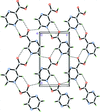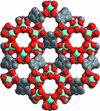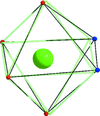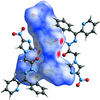issue contents
March 2019 issue

Cover illustration: A cocrystal and a molecular salt of ![[beta]](/logos/entities/beta_rmgif.gif) -alanine and DL-tartaric acid do not interconvert in the solid state over a wide temperature range, though such a transformation can be solvent-mediated. See Losev & Boldyreva [Acta Cryst. (2018), C74, 313-319].
-alanine and DL-tartaric acid do not interconvert in the solid state over a wide temperature range, though such a transformation can be solvent-mediated. See Losev & Boldyreva [Acta Cryst. (2018), C74, 313-319].
feature articles
This review highlights different aspects of the pyrazine ligand and its derivatives for the construction of metal complexes having multinuclear structures.
research papers
Download citation


Download citation


A new half-sandwich tantalum(V) dichlorido complex containing the O,N,O′-tridentate double-deprotonated 2-ethoxy-6-{(E)-[(2-oxidophenyl)imino]methyl}phenolate ligand was prepared, thoroughly characterized and revealed considerable in vitro cytotoxicity against the A2780 human ovarian carcinoma cell line.
CCDC reference: 1893190
Download citation


Download citation


The title structures represent rare examples of metal complexes comprising a 3,4-disubstituted pyrazole derivative as a bridging ligand and the first crystal structures of metal complexes with a 4-nitropyrazole-3-carboxylic acid-based ligand.
Download citation


Download citation


Calix[4]arene and oxacalix[4]arene derivatives have eight possible conformations in the up and down directions of their four aromatic rings from the mean plane of a bridged central ring, the conformations of which determine the functionality of the host frameworks.
Download citation


Download citation


The molecular structure of J147 has been determined at 150 K and corresponds to the minimum-energy conformation in the gas phase calculated by DFT. 15 other conformations have been calculated and compared with the minimum.
CCDC reference: 1869097
Download citation


Download citation


A three-dimensional NBO-type topological metal–organic framework (MOF) formed from zinc(II) and para-terphenyl-3,3′,5,5′-tetracarboxylate was synthesized by solvothermal reaction.
CCDC reference: 1894907
Download citation


Download citation


The crystal structures of seven α-aryl-α-hydroxyphosphonates synthesized by the Pudovik reaction of substituted benzaldehydes and dialkyl phosphites were studied to gain a better understanding of the organization in this type of molecule in the solid state. The crystal structures show a balance between the C—OH⋯O=P chain-linked packing and the dimeric types of hydrogen-bond bridges of intermolecular pairs of such functions.
Download citation


Download citation


Reactions of 1,10-phenanthroline (phen) and 2-(3,4-dichlorophenyl)acetic acid (dcaH) with Mn(CO3) (M = LiI, NaI and MgII; n = 1 and 2) in MeOH yield the mononuclear lithium complex, the dinuclear sodium complex and the one-dimensional chain magnesium complex. In these complexes, phen binds via an N,N′-chelate pocket, while the deprotonated dca− ligands coordinate either in a monodentate or bidentate fashion.
Download citation


Download citation


Crystallographic identification of a series of manganese porphyrin complexes with nitrogenous bases
Syntheses, crystal and molecular structures, and binding constants are reported for four manganese(III) porphyrin complexes.
Download citation


Download citation


A cocrystal and a molecular salt of β-alanine and DL-tartaric acid do not interconvert in the solid state over a wide temperature range, though such a transformation can be solvent-mediated.
Download citation


Download citation


Three imidazole hydrazone compounds were prepared and characterized. The compounds proved not to be cytotoxic to J774.A1 macrophage cells. Two of the hydrazones exhibited activity against Leishmania chagasi, whereas the third was inactive. The presence of a 4-nitro group probably favours antileishmanial activity over the 2-nitro group.
Download citation


Download citation


The isostructural salts benzene-1,2-diaminium bis(pyridine-2-carboxylate), 4,5-dimethylbenzene-1,2-diaminium bis(pyridine-2-carboxylate) and the 1:2 benzene-1,2-diamine–benzoic acid cocrystal are reported. Hydrogen-bonding, π–π, and C—H⋯π interactions are explored.
Download citation


Download citation


The structures of an 18-membered azamacrocycle containing two disselenide linkages and its precusor are reported.
Download citation


Download citation


The reaction of 3-(3,5-di-tert-butyl-4-hydroxyphenyl)-1-phenylprop-2-en-1-one with HCl or HBr in MeOH of EtOH leads to the haloetherification products 3-(3-tert-butyl-5-halo-4-hydroxyphenyl)-2-halo-3-alkoxy-1-phenylpropan-1-ones. Both intermolecular hydrogen and halogen bonds were found in the crystal structures of the haloetherification products of chalcone.
Download citation


Download citation


The solid-state structure of the cocrystal salt tetraaquabis[trans-1,2-bis(pyridin-4-yl)ethene]iron(II) bis(1,1,3,3-tetracyano-2-ethoxypropenide)–trans-1,2-bis(pyridin-4-yl)ethene (1/2) is reported. Density functional theory is used to explore the strengths of the observed O—H⋯N hydrogen bonding and π–π intermolecular interactions.
CCDC reference: 1897613
Download citation


Download citation


A twisted 2D layered anion structure is formed because of the infiltration of cations and the presence of hydrogen bonds. A band gap of ∼2.700 eV was found through experimental and theoretical studies.
CCDC reference: 1883687
Download citation


Download citation


A catalyst- and solvent-free approach for the regioselective synthesis of 2-fluoro-N-(3-methylsulfanyl-1H-1,2,4-triazol-5-yl)benzamide through a microwave-assisted Fries rearrangement of (5-amino-3-methylsulfanyl-1H-1,2,4-triazol-1-yl)(2-fluorophenyl)methanone is provided. The structures of the synthesized amides, tautomerism and the mechanistic pathway were determined by X-ray structure and theoretical studies.
Download citation


Download citation


A fourfold interpenetrating cadmium(II) metal–organic framework, which has been prepared using the 2,4,6-tris(pyridin-4-yl)-1,3,5-triazine ligand, exhibits prominent photochromic behaviour upon UV–Vis light irradiation.
CCDC reference: 1898726


 journal menu
journal menu



































